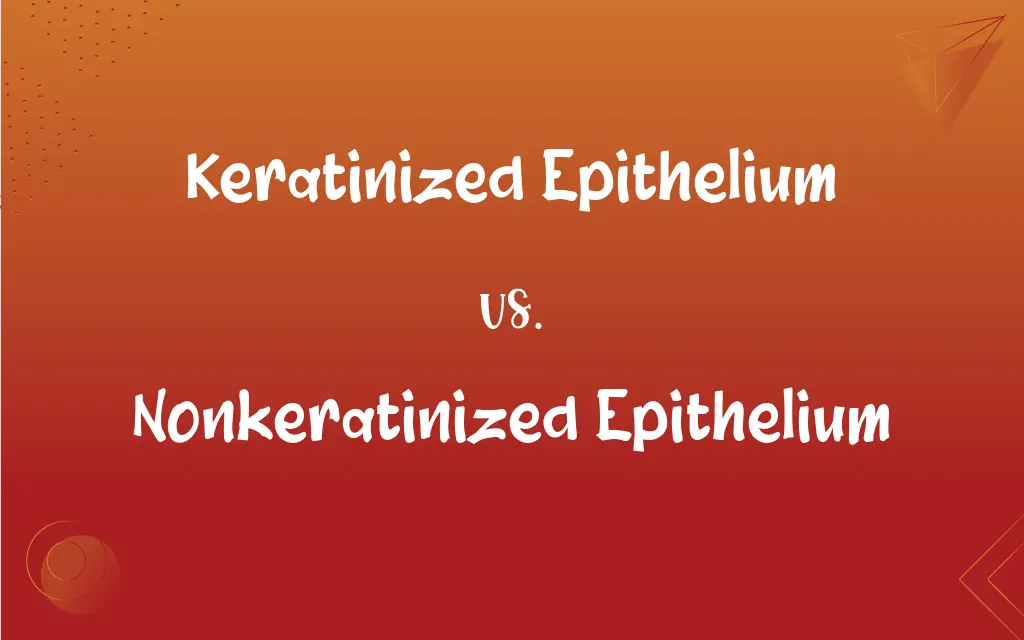Keratinized Epithelium vs. Nonkeratinized Epithelium: What's the Difference?
Edited by Aimie Carlson || By Harlon Moss || Published on February 11, 2024
Keratinized epithelium has a layer of dead cells with keratin protein, providing protection; nonkeratinized epithelium lacks this, allowing flexibility and moisture retention.

Key Differences
Keratinized Epithelium is a type of tissue characterized by its surface layer of dead cells filled with keratin, a protective protein. This structure is typically found in areas of the body that require a tough, protective barrier, like the skin. In contrast, nonkeratinized epithelium lacks a surface layer of dead cells. It remains moist and flexible, which is essential for tissues that need to provide a moist, protective layer, such as the lining of the mouth and esophagus.
Keratinized Epithelium commonly found on the skin's surface, this epithelium is adapted to withstand abrasion and prevent water loss, crucial for external body surfaces. Nonkeratinized Epithelium is typically located in internal wet surfaces like the mouth, throat, anus, and vagina. The lack of keratin allows these areas to remain moist and better adapt to their environment.
Keratinized Epithelium offers excellent protection against environmental damage, such as pathogens and physical abrasion, but it's less sensitive to touch due to the thick keratinized layer. Nonkeratinized Epithelium, while offering less physical protection, it's more sensitive to touch and temperature changes, making it suitable for internal body linings where sensation is important.
Keratinized Epithelium has a high rate of cellular turnover. Dead cells on the surface are continuously replaced by new cells from below. Nonkeratinized Epithelium also exhibits cellular turnover, but without forming a layer of dead, keratinized cells, maintaining a moist surface.
Comparison Chart
Surface Layer
Dead cells with keratin
Live cells, no keratin
ADVERTISEMENT
Location
Skin, external surfaces
Mouth, esophagus, internal linings
Function
Protection, water resistance
Flexibility, moisture retention
Sensitivity
Less sensitive
More sensitive
Appearance
Dry and thick
Moist and shiny
Keratinized Epithelium and Nonkeratinized Epithelium Definitions
Keratinized Epithelium
A tissue with a surface layer of dead, keratin-filled cells.
The keratinized epithelium of the skin protects against environmental damage.
ADVERTISEMENT
Nonkeratinized Epithelium
Flexible and moist epithelial tissue.
Nonkeratinized epithelium lines the esophagus, aiding in smooth food passage.
Keratinized Epithelium
Dry, tough layer of epithelium.
The keratinized epithelium on our hands helps us grip objects better.
Nonkeratinized Epithelium
Sensitive tissue without a protective keratin layer.
The nonkeratinized epithelium in the throat helps detect swallowed food's texture.
Keratinized Epithelium
Epithelium with a high rate of cell turnover.
The keratinized epithelium of the scalp sheds dead cells as dandruff.
Nonkeratinized Epithelium
A tissue layer without a keratinized surface, maintaining moisture.
The nonkeratinized epithelium in the mouth keeps it moist for easier food processing.
Keratinized Epithelium
Epithelial tissue adapted for protective functions.
Calluses are areas of thick keratinized epithelium developed from repeated friction.
Nonkeratinized Epithelium
Epithelium found in internal, wet body surfaces.
The nonkeratinized epithelium in the vagina provides a moist environment essential for its functions.
Keratinized Epithelium
A barrier against pathogens and physical damage.
Keratinized epithelium on the feet is essential for walking on rough surfaces.
Nonkeratinized Epithelium
A layer of live cells, continuously renewed.
Nonkeratinized epithelium in the anus aids in maintaining the necessary moisture for excretion.
FAQs
Where is keratinized epithelium found?
Primarily on the skin's surface and other external areas of the body.
Is keratinized epithelium sensitive to touch?
It's less sensitive due to the thick layer of dead cells.
What is the main role of nonkeratinized epithelium?
To provide a moist, protective lining that allows flexibility.
How does keratinized epithelium protect the body?
By creating a tough barrier with its keratin-filled dead cells.
What is keratinized epithelium?
It's a tissue with a surface layer of dead cells filled with keratin, providing a protective barrier.
Can keratinized epithelium heal quickly?
It can heal, but the rate varies depending on the damage extent.
Does nonkeratinized epithelium contain keratin at all?
No, it lacks the keratin protein found in keratinized epithelium.
Can nonkeratinized epithelium resist water loss?
No, it's not adapted for water resistance like keratinized epithelium.
What is the main function of keratinized epithelium?
To protect against physical abrasion and water loss.
Can nonkeratinized epithelium withstand harsh environments?
Not as effectively as keratinized epithelium; it's suited for internal, less harsh environments.
What is nonkeratinized epithelium?
It's an epithelial tissue without a keratin layer, remaining moist and flexible.
Where is nonkeratinized epithelium located?
In internal wet areas like the mouth, throat, and other body cavities.
Does nonkeratinized epithelium offer any protection?
Yes, it provides some protection but is more focused on maintaining moisture and flexibility.
What happens to the dead cells in keratinized epithelium?
They are shed and replaced by new cells from the underlying layers.
Is nonkeratinized epithelium more sensitive than keratinized epithelium?
Yes, it's more sensitive to touch and temperature changes.
Do both types of epithelium undergo cell turnover?
Yes, both types constantly renew their cells, but in different ways.
Is keratinized epithelium waterproof?
Yes, its keratin layer provides water-resistant properties.
How does nonkeratinized epithelium contribute to body functions?
It aids in processes like digestion and excretion by providing a smooth, moist lining.
Why doesn't nonkeratinized epithelium have a layer of dead cells?
It's designed to stay moist and flexible, which wouldn't be possible with a layer of dead cells.
Can keratinized epithelium be found inside the body?
Rarely, as it's mainly adapted for external body surfaces.
About Author
Written by
Harlon MossHarlon is a seasoned quality moderator and accomplished content writer for Difference Wiki. An alumnus of the prestigious University of California, he earned his degree in Computer Science. Leveraging his academic background, Harlon brings a meticulous and informed perspective to his work, ensuring content accuracy and excellence.
Edited by
Aimie CarlsonAimie Carlson, holding a master's degree in English literature, is a fervent English language enthusiast. She lends her writing talents to Difference Wiki, a prominent website that specializes in comparisons, offering readers insightful analyses that both captivate and inform.







































































